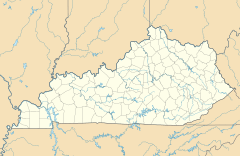Garrard, Kentucky facts for kids
Quick facts for kids
Garrard
|
|
|---|---|
|
village
|
|
| Country | United States |
| State | Kentucky |
| County | Clay |
| Elevation | 866 ft (264 m) |
| Time zone | UTC-6 (Eastern (EST)) |
| • Summer (DST) | UTC-5 (CST) |
| ZIP codes |
40941
|
| GNIS feature ID | 512280 |
Garrard is a small community in Clay County, Kentucky, United States. It's located where United States Highway 421 and Kentucky Highway 80 meet, about 2.5 miles (4.0 km) south of Manchester.
Garrard started in 1806 as a place where salt was made. Daniel Garrard (1780–1866), son of James Garrard, set up a "salt works" here. He had bought the land in 1798. For a long time, it was known by other names like the Goose Creek Salt Works or The Salt Works. The name Garrard wasn't officially used until 1917, when the Cumberland and Manchester Railroad came through.
The post office in Garrard opened on April 28, 1917. It was named Garrard, possibly after James Garrard's great-grandsons, William Toulmin Garrard and Edward Gibson Garrard, who owned the land. Another idea is that it was named after James's grandson, Theophilus T. Garrard.
Contents
Garrard Family History
Many members of the Garrard family were born at the salt works. Some of them include Eliza Ann Garrard (born 1809), James H. Garrard, Theophilus T. Garrard, Edward Pendleton Garrard (born 1814), and William Mountjoy Garrard (born 1822).
Salt Works in the 1800s
Decline and Civil War Impact
The salt works at Garrard faced tough times even before the United States Civil War. The Goose Creek river, which was important for shipping salt, wasn't always easy to travel on. People tried to improve the river, but it was difficult.
During the Civil War, the salt works were very important. Confederate (Southern) forces captured Manchester in 1862 and took a lot of salt from Garrard and other salt works nearby. To stop the Confederate army from getting more salt, the Union (Northern) army decided to destroy the salt works.
In 1862, 500 Union soldiers spent 36 hours destroying the salt works. They broke furnaces, pumps, and wells. They also dumped about 30,000 US bushels (1,100,000 L) of salt into the rivers. Some local people who supported the Union were allowed to take a small amount of salt for themselves.
After the war, Theophilus T. Garrard asked the government for money because of the damage, but his request was denied. Even though the salt works were rebuilt, they never became as important as they were before the war. This was because other salt works started producing more, and better transportation made salt cheaper to buy from other places.
Challenges with Transportation
Getting salt to market was always a problem because Goose Creek river was only navigable at certain times of the year. Daniel Garrard and others tried to clear the river to make it easier for boats. In 1818, Daniel Garrard used 32 of his workers to clear obstacles from the South Fork Kentucky River.
There were ideas for bigger transportation projects, like building a canal connecting the salt works to other major rivers. One plan in 1836 suggested a canal from the salt works to the Cumberland River at Barboursville. A survey was done in 1837, but the plan never happened.
The Railway Era
By the mid-1900s, Garrard had a railway stop. The Louisville and Nashville Railroad had a large water tank there. This tank held 63,000 US gallons (240,000 L) of water and supplied 12,000 US gallons (45,000 L) each day to steam locomotives, which were trains powered by steam.



